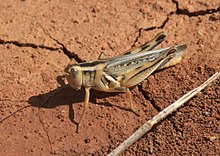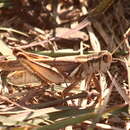Conservation Status
fourni par University of Alberta Museums
At high densities the Packard grasshopper can cause damage to grain crops and alfalfa, but at its usual low densities it is not a pest because of its preference for poor forage plants (Pfadt 2002).
- licence
- cc-by-nc
- droit d’auteur
- University of Alberta Museums
Cyclicity
fourni par University of Alberta Museums
Melanoplus packardii nymphs (no wings or short wing buds) hatch from May to early June. Adults (wings extend the length of the abdomen or beyond) can be found about 47 to 63 days after the nymphs have hatched and due to their longevity a sizable population lives through August and September (Pfadt 2002). This grasshopper has been collected in July and August in Alberta (Strickland Museum records).
- licence
- cc-by-nc
- droit d’auteur
- University of Alberta Museums
Distribution
fourni par University of Alberta Museums
This species can be found in the southern half of British Columbia, Alberta, Saskatchewan, and the southern edge of Manitoba. It ranges broadly across the western half of the United States down to the northern edge of Mexico (based on range map in Pfadt 2002). Records indicate that this grasshopper can be found as far north as Fairview in Alberta (Strickland Museum).
- licence
- cc-by-nc
- droit d’auteur
- University of Alberta Museums
General Description
fourni par University of Alberta Museums
The Melanoplus packardii is a large spurthroated grasshopper with long wings extending as much as 6 mm beyond the end of the abdomen. This and other grasshoppers of the subfamily Melanoplinae often have a spiny bump on their "throat" between their front legs (Johnson 2002). It has bright tan, brown and yellow colour patterns. Two bright stripes run down the head and disk of the pronotum. Cerci of the males are spatulate and the supraanal plate (the cup-shaped plate at the end of the male abdomen) narrows gradually to the pointed end. Females can be identified by using size, markers and colouring to associate them with the males (Pfadt 2002).
- licence
- cc-by-nc
- droit d’auteur
- University of Alberta Museums
Habitat
fourni par University of Alberta Museums
The Packard grasshopper inhabits grasslands, croplands, and mountain meadows of western North America (Pfadt 2002).
- licence
- cc-by-nc
- droit d’auteur
- University of Alberta Museums
Life Cycle
fourni par University of Alberta Museums
The life cycle of this species is described in Pfadt's Field Guide to Common Western Grasshoppers (2002). After mating, the eggs mature in the female for about 20 days before oviposition. About 16 to 29 tan eggs are deposited in bare ground in a slightly curved pod about 3 cm long.
- licence
- cc-by-nc
- droit d’auteur
- University of Alberta Museums
Trophic Strategy
fourni par University of Alberta Museums
The Packardgrasshopper consumes both grasses and forbs, but seems to prefer legumes including milkvetch, loco, peavine, and scurfpeas (Pfadt 2002).
- licence
- cc-by-nc
- droit d’auteur
- University of Alberta Museums
Melanoplus packardii
(
anglais
)
fourni par wikipedia EN
Melanoplus packardii, known generally as the "Packard's grasshopper", is a species of spur-throated grasshoppers in the family Acrididae.[1][2] It is found in North America.[2]

Packard's Grasshopper,
Melanoplus packardii, Major, OK, USA
[3]
References
- Capinera J.L, Scott R.D., Walker T.J. (2004). Field Guide to Grasshoppers, Katydids, and Crickets of the United States. Cornell University Press.
- Otte, Daniel (1995). "Grasshoppers [Acridomorpha] C". Orthoptera Species File 4, 518.
- licence
- cc-by-sa-3.0
- droit d’auteur
- Wikipedia authors and editors
Melanoplus packardii: Brief Summary
(
anglais
)
fourni par wikipedia EN
Melanoplus packardii, known generally as the "Packard's grasshopper", is a species of spur-throated grasshoppers in the family Acrididae. It is found in North America.

Packard's Grasshopper, Melanoplus packardii, Major, OK, USA
- licence
- cc-by-sa-3.0
- droit d’auteur
- Wikipedia authors and editors
Melanoplus packardii
(
espagnol ; castillan
)
fourni par wikipedia ES
Melanoplus packardii[nota 1] es una especie de saltamontes perteneciente a la familia Acrididae.[1][2] Se encuentra en América del Norte.[2]
Notas
-
↑ En inglés es conocido como packard's grasshopper.
Referencias
Bibliografía
- Capinera J. L., Scott R. D., Walker T. J. (2004). Field Guide to Grasshoppers, Katydids, and Crickets of the United States. Cornell University Press.
- Otte, Daniel (1995). «Grasshoppers [Acridomorpha] C». Orthoptera Species File 4, 518.

- licence
- cc-by-sa-3.0
- droit d’auteur
- Autores y editores de Wikipedia
Melanoplus packardii: Brief Summary
(
espagnol ; castillan
)
fourni par wikipedia ES
Melanoplus packardii es una especie de saltamontes perteneciente a la familia Acrididae. Se encuentra en América del Norte.
- licence
- cc-by-sa-3.0
- droit d’auteur
- Autores y editores de Wikipedia
Melanoplus packardii
(
néerlandais ; flamand
)
fourni par wikipedia NL
Insecten Melanoplus packardii is een rechtvleugelig insect uit de familie veldsprinkhanen (Acrididae). De wetenschappelijke naam van deze soort is voor het eerst geldig gepubliceerd in 1878 door Scudder.
Bronnen, noten en/of referenties Geplaatst op:
22-04-2013
Dit artikel is een beginnetje over biologie. U wordt uitgenodigd om op bewerken te klikken om uw kennis aan dit artikel toe te voegen.

- licence
- cc-by-sa-3.0
- droit d’auteur
- Wikipedia-auteurs en -editors



 Packard's Grasshopper, Melanoplus packardii, Major, OK, USA
Packard's Grasshopper, Melanoplus packardii, Major, OK, USA